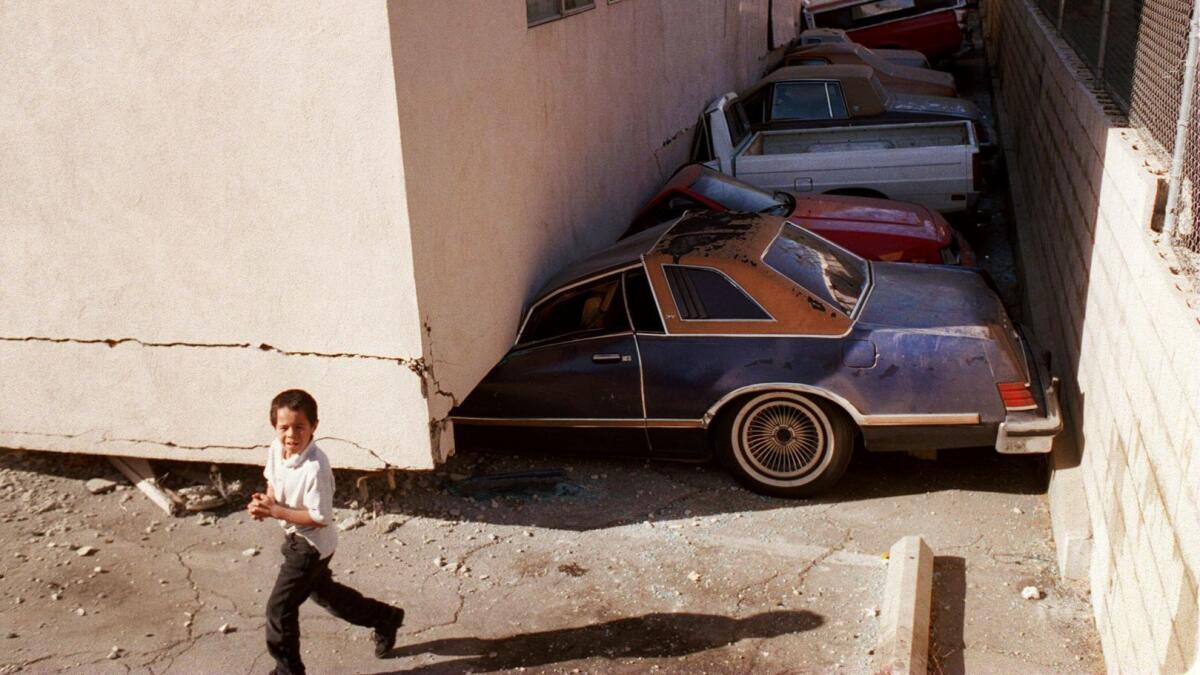Op-Ed: The California earthquake drought is an opportunity. Will we take it?

Research published this week confirmed that California has been in a century-long earthquake drought. Analysis of geologic records on the state’s main faults — the San Andreas, San Jacinto and Hayward — going back 1,000 years shows that the gaps between large quakes are, currently, longer than to be expected from random variation. Southern California has been particularly quiet for the last 25 years, with the rate of small and moderate earthquakes almost half of what it had been in the previous half a century.
This hiatus in major shaking means that we aren’t getting as much movement as plate tectonics require. So at some point we’ll start having more frequent earthquakes, and things will — over geologic time — average out again. (We won’t necessarily have a bigger earthquake, just a period in which they are more frequent.)
As the U.S. Geological Survey scientists point out, because we don’t know why we are in a drought, we don’t know when it will end.
But we do know that it will end. The Pacific plate is still on its very slow move carrying Los Angeles toward San Francisco. Just as the rains came this winter, some year the big earthquake will come.
Just as the rains came this winter, some year the big earthquake will come.
What happens to our communities then will depend on how well we have prepared. Granted, if the drought ends next month, we won’t be in any better shape than we are today. But maybe we have two years. Or five. Even 10. How will we use that time?
We know that cities can never be made fully “earthquake-proof.” It makes no economic sense to tear down every building and put up a super-strong replacement. There are, however, many known vulnerabilities that, if left unaddressed, will kill some of us, make all our lives more difficult after the earthquake, and make our recovery longer and more painful.
We could continue to improve our new buildings. Right now most seismic building codes are designed to save lives, but with more changes we could also save the buildings. For an estimated 1% increase in construction costs, our new buildings would be repairable, not torn down, after an earthquake. Strengthening existing soft-first-story buildings (buildings with big openings like carports on the first floor, like the Northridge Meadows apartments that collapsed in 1994) across Southern California could mean that hundreds of thousands of families would be more likely to have a home they can still live in after the quake. How many more families could we protect?
Other cities could join Los Angeles in fortifying our water systems. Every strengthened water pipe means a business that will be able to reopen after the event because they have water. How much more of our economy could we protect?
We could engage community organizations and nonprofits to be ready. If a church is badly damaged and the food bank it runs isn’t functioning, many more people will go hungry. If a mosque is destroyed, will the people in that community feel isolated and decide to move away? Organizations need to connect with one another now, so they can support one another and recover after the quake. How many communities could we protect?
Enter the Fray: First takes on the news of the minute from L.A. Times Opinion »
As individuals, we can talk about the earthquake threat. Talk with your family about having a plan, and make your home safer. Get an earthquake insurance quote, too; it may be cheaper than you think. Get that fire extinguisher and water supply you have thought about but not actually purchased. How many people in your own household could you protect?
If we decide to do nothing, when the drought ends, California will be no better off than we are today, facing a likely $200 billion in economic damage, businesses closed for many months and more than 50,000 injuries from one earthquake on the San Andreas fault.
A whole generation of Californians have now grown up without experiencing a damaging earthquake, and some people worry that we’ve become complacent about seismic safety here. But that’s not what I see. In fact, many of these steps are being taken. Since 2012, eight California cities have passed mandatory retrofit ordinances and many more are considering it. The question is how fast and aggressively the work gets done.
The earthquake drought is giving us a chance to make better decisions and reduce our losses. Will we take it?
Lucy Jones was a seismologist with the U.S. Geological Survey for 33 years and founded the Dr. Lucy Jones Center for Science and Society focused on creating resilient communities in 2016. She continues to work at Caltech and is the author of the book “The Big Ones.”
Follow the Opinion section on Twitter @latimesopinionand Facebook
More to Read
A cure for the common opinion
Get thought-provoking perspectives with our weekly newsletter.
You may occasionally receive promotional content from the Los Angeles Times.










